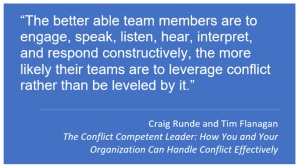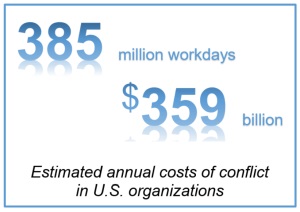Conflict Resolution in the Workplace: Win/Win Training Benefits Employees and Organizations

Minimizing the Impact of Workplace Conflict
“I’ve had a stomach ache, a migraine, or both almost every day for the last three months,” lamented Marie. “Since things changed at work and Amy joined our team, it’s been nothing but problems—for me, anyway. She interferes with projects I’m supposed to handle, doesn’t share information that everyone on our team needs, and she’s convinced she’s always right.”
My friend Marie works for a large healthcare system, supervising a team of employees who provide services to patients and their families. Marie has nearly 20 years’ tenure with the company. She used to love her job. But conflict with her new colleague has changed that. And, if her physical health continues to deteriorate, she fears she may have to leave work and apply for disability.
“Have you talked to Amy? Tried to work this out?” I asked Marie.


“I’ve said a couple of things to her. But I’m just not comfortable with confrontation,” she told me. “In my family, we don’t get in each other’s faces about things. I don’t know how to do that. Anyway, that should be our boss’s job. But when I went to her, she told me I should work it out with Amy myself. I just feel trapped. And my head is killing me."
“I can understand that your boss wants you to handle situations yourself when you can,” I acknowledged. “But it must have felt as if she let you down. Could you perhaps ask her for some coaching to help you better understand how to approach this situation with Amy?”According to Marie, her boss made it clear that asking for guidance or intervention wasn’t an option—since she was a supervisor, she was expected to handle these types of situations on her own. Unfortunately, that left my friend feeling frustrated and helpless to change things.
A Different Outcome
I can’t help but contrast Marie’s predicament with an experience another acquaintance, Jan, shared with me. She, too, found herself in a contentious relationship with a co-worker when she transferred back into a social work investigative unit where she’d been employed in the past.


“Terry wasn’t someone I’d worked with before,” Jan explained. “He was recently promoted and new to the unit. But soon after I returned, I learned that Terry had been complaining about me to our co-workers. Even worse, to my boss. And what he said was not only unkind, it was completely fabricated: that I’d neglected work, that it was throwing others behind and adding to the unit’s workload. Nothing could have been further from the truth.”
“If I’d been in your shoes, that would’ve made me angry,” I admitted. “You’re not someone to put up with that kind of thing. How did you handle it?”
“Well, you’re right,” Jan agreed. “I knew I had done nothing to deserve the falsehoods Terry was spreading. And I was determined to put a stop to it.”
Jan started with her manager. She confirmed the on-time status of her projects and explained that she’d done none of the things Terry alleged. Further, she advised, she’d speak with Terry next, engaging in a direct conversation with him to resolve the situation.
That’s just what Jan did. Calmly, but firmly, she confronted Terry about his actions. She demonstrated that her projects were on schedule and asked why he’d tried to undermine her. The outcome? Anxious to prove himself after his recent promotion, Terry was in over his head and falling behind. He admitted that slamming Jan was his attempt to divert attention from his own work problems.


Instead of holding a grudge, Jan, who was a seasoned veteran of the investigative unit, offered to help Terry organize his new workload and get up to speed on the unit’s procedures. Since she needed to refresh her own knowledge, she teamed with Terry for a few weeks, enhancing the learning process for both. Eventually, the colleagues became friends.
While both Marie and Jan experienced conflict in the workplace, their reactions were vastly different, leaving one miserable and the other able to achieve a win/win outcome.
The difference? Training. A previous employer’s workforce conflict resolution training armed Jan with the knowledge and skills she needed to constructively deal with the issues she’d encountered—skills Marie needs desperately.
Workplace Conflict Happens All-Too-Often
Just how often do situations like those faced by Marie and Jan occur? Widely cited global research on workplace conflict by CPP Inc. (publisher of the well-known Myers-Briggs Type Indicator®) reported that 85% of 5,000 surveyed employees across all organizational levels say they regularly deal with conflict at work. More than a third (36%) of U.S. employees said they encounter that conflict on a nearly constant basis.
When workplace conflict isn’t handled well, situations quickly go from bad to worse. Nearly nine in 10 employees admitted that they’d seen conflicts escalate, sometimes to the point of violence. Almost three in 10 said that recent issues in their organizations took days to resolve, and 16% acknowledged that conflicts remained unsettled.
Although altercations between workers in entry-level and frontline roles happened most often, managers weren’t immune. Conflict between managers and their reports, managers and other managers, and even among senior-level executives were reported in significant numbers.


Personality and ego clashes—like those that challenged Marie and Jan—are the leading causes of workplace conflict, with encounters reported by almost half of employees. Stress, heavy workloads, inadequate resources, poor leadership, and dishonesty are other common contributors.
Conflict Costs Organizations and Employees
When workplace conflict isn’t resolved effectively the results are costly—for organizations and individuals, alike.
In the U.S., employees spend an average of 2.8 hours each week trying to deal with the fallout from poorly managed conflict. That’s the time equivalent of more than a full workday every month. All told, estimates put the total spent on handling conflict in U.S. organizations at 385 million workdays every year. In dollars, the figure is about $359 billion.


As startling as those loss estimates may be, they aren’t the only prices organizations pay when they fail to resolve conflict. Lost talent, increased absenteeism and sick leave use, lost customers, lower productivity, decline in operational performance, negative effects on morale, and damage to corporate culture—the potential costs are staggering, and all pose serious business risks.
Employers aren’t the only ones shouldering the burden. Employees pay prices of their own. For Marie and others like her, physical costs are troubling.
As many as 25% of employees say that workplace conflict has caused them illness and led to absences and lost job time. Others report feeling nervous, stressed, frustrated, angry, and less motivated. They also blame conflicts at work for undermining teams, causing distractions, and resulting in project failures.
Employees like Marie tend to take the impact of workplace conflict home, feeling the fallout in their personal lives, too. Depression and physical symptoms keep them from enjoying time off. And individuals who are unable to work out issues on the job also are likely to lack the skills they need to resolve conflict when it arises with family members and friends.
Handling Conflict Effectively Offers Benefits
Despite the business risks, personal fallout, and other potential damage associated with workplace conflict, there are silver linings to be realized when employees and managers know how to take appropriate action to constructively resolve problems. Here are a few of the top benefits organizations and employees can achieve when workplace conflict is handled effectively:


Organizational Benefits
- Improved workforce morale
- Higher levels of engagement
- Stronger teamwork
- Enhanced productivity
- Better overall organizational performance
- Stronger business results
- Improved talent retention/lower turnover
- Reduced absences
- Greater levels of creativity and innovation
Individual Benefits
- Greater comfort with and understanding of others
- Improved morale and engagement
- Improved personal productivity
- Better relationships at work
- Improved team performance
- Greater creativity and innovation
- Enhanced problem-solving ability
- Improved health and wellness
- Reduced absenteeism
- Improvements in personal lives
Naturally the benefits to be gained from effective resolution of workplace conflict will vary for organizations and their employees. But it is clear to see that there is much to lose when conflict goes unaddressed, and much to gain when those facing conflict know how to take appropriate action.
Workplace Conflict Resolution Training is the Answer
The key to arming managers and employees with the skills, and confidence they need to effectively resolve workplace conflict is training. Well-designed training enables everyone in the organization to acquire the knowledge, the capabilities, and the mindset needed to proactively resolve conflict—competencies increasingly seen by HR and learning leaders as core job competencies across all organizational roles.
Making workplace conflict resolution training an integral part of your learning and development strategies unlocks your organization’s ability to empower better performance by establishing a company-wide language for talking about conflict, and by emphasizing the benefits to be gained when issues are openly addressed.
Of course, managers and HR functions will continue to be important resources for employees, ready to step in when situations transcend ordinary workplace conflict. Your training approach should include building awareness of the difference between conflict employees can handle themselves, and serious issues that demand an organizational response (such as bullying, harassment, sexual misconduct, etc.) It’s also important to emphasize that, even though ego and personality clashes account for many workplace conflicts, successful resolution keeps the focus on behaviors and issues, not on the people involved.
Media Partners’ Right/Wrong to WIN/WIN: Peer-to-Peer Conflict Resolution video teaches a clear 5-step process to guide people in shifting the focus of conflict from personal differences to constructive solutions of problems that hamper on-the-job success.
From frontline employees to C-level executives, everyone in the organization can quickly learn to apply new conflict resolution tactics in the workplace. That same know-how can turn your company culture into one in which conflict no longer stifles success. Employees will gain new life skills that help diffuse conflicts, both within and outside the workplace. Better work life, better home life is a win/win for all.
Right/Wrong to WIN/WIN: Peer-to-Peer Conflict Resolution is available for full-length preview now on the Media Partners website. View it today to see just how powerful 13 minutes of life-changing training can be.
References:

